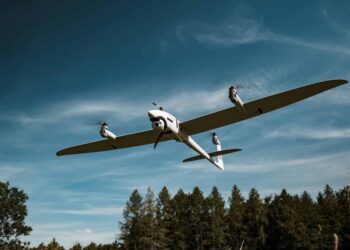US Air Force, EDWARDS AIR FORCE BASE: A Global Hawk unmanned aerial vehicle known as N-1 took off from Edwards' main runway March 27 on a one-way mission to Naval Air Station Patuxent River, Md.
The N-1, an RQ-4A Global Hawk — one of two acquired by the U.S. Navy through the Global Hawk Maritime Demonstration Program — is the first of its kind delivered to the Navy, and is being prepared for participation in the Navy's Joint Expeditionary Force Experiment 2006.
“The successful delivery of N-1 to Pax River marks a major milestone in the joint development of the Global Hawk reconnaissance system,” said Col. Christopher Cook, 412th Operations Group commander.
The delivery was enabled by the installation of a launch and recovery element at NAS Patuxent River that now allows the Navy to begin and end their missions at their own airfield. Before this installation all Navy work had to originate from Edwards, Colonel Cook said.
“I know that the 452nd Flight Test Squadron and the 412th Test Wing look forward to our continuing partnership with our Navy teammates in providing the best capability possible to our combatant commanders,” Colonel Cook said.
Before its flight to the East Coast, the aircraft was deemed safe for flight in national airspace by a military airworthiness certificate accomplished by the Global Vigilance Combined Test Force here, a first for an unmanned system.
“Airworthiness certification is a critical step to any new aircraft, but probably even more so in an unmanned aircraft program because it tells the various stakeholders in the aviation community (Federal Aviation Administration, operation commands, foreign airspace authorities, etc.) that the Global Hawk system meets the accepted standards to operate as an aircraft,” said Tony Kaiser, 412th Test Wing project manager for Global Hawk. “The flight testing of the original YR-4A and production RQ-4A aircraft supported the airworthiness certification.”
Flight testing of the RQ-4A Global Hawk was accomplished here to evaluate the performance of sensor modifications for the Navy. These modifications were developed beginning in 2001 when the Global Hawk program, in association with the Australian government, developed maritime modes for the Global Hawk's Synthetic Aperture Radar.
“These modes were initially tested at Edwards, and then demonstrated during a deployment to (Royal Australian Air Force Base) Edinburgh in Australia in the fall of 2001,” Mr. Kaiser said. “The U.S. Navy adapted these modes to the production Global Hawk SAR and developed maritime modes that met their requirements. These maritime modes were again tested at Edwards by a combined Global Vigilance CTF and Navy test team.”
With the testing and airworthiness proven, the final challenge of delivering N-1 to the Navy was the planning and execution of the cross-country flight.
“The ferry of an unmanned vehicle across the United States is a very complex task,” Mr. Kaiser said. “A unique mission plan must be built that keeps Global Hawk away from population centers and congested FAA airspace. The mission plan also has to accommodate emergency planning that would allow the aircraft to recover to an alternate runway or unpopulated ground area across the entire continent.”
The flight route was coordinated with the FAA and other airspace controlling agencies across the United States and all emergency landing points were coordinated with their owners.
Germany says adding explosive drones to weapons arsenal
Germany said Friday it would buy explosive drones for the first time as Berlin boosts investments in its armed forces...









